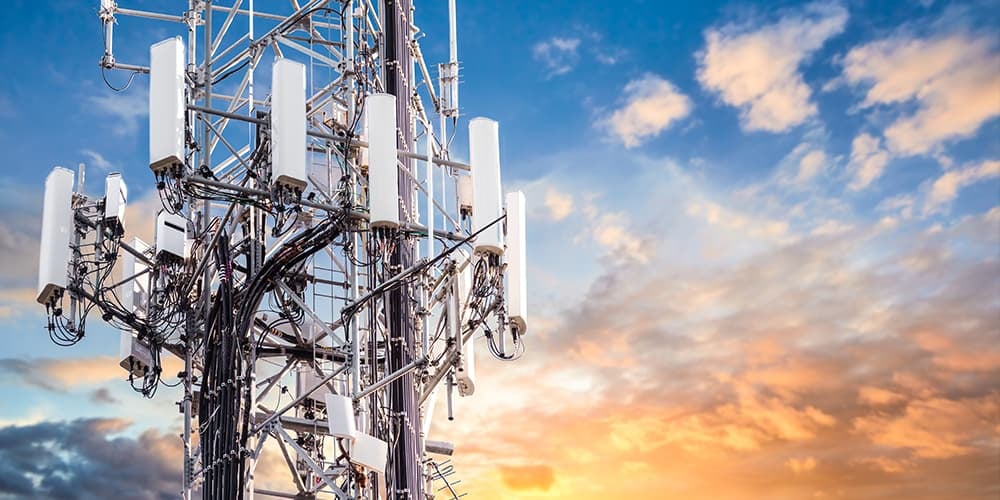The need to provide seamless wireless connectivity at ultrafast speed for millions of devices has caused 4G to reach maximum capacity. A new form of connectivity is needed to meet the evolved needs of mobile users and to satiate society’s new digital content consumption habits.
This is where 5G cell towers come into play.
5G will provide faster speeds, greater capacity, ultra-low latency, and better support for Internet of Things (IoT) devices. However, mobile users can’t experience full 5G capabilities until there is a comprehensive network of new and upgraded 5G cell towers.
Due to the rising need for new cellular infrastructure, here is everything tower owners and mobile network operators need to know about 5G cell towers to get ahead of the competition by proactively expanding or upgrading their current tower network.
What are 5G Cell Towers and How Do They Work?
5G towers are telecommunications sites capable of transmitting 5G “New Radio” signals for wide-area coverage. They are typically 50 to 200 feet tall and designed to blend into the natural environment to limit the aesthetic impact.
5G cell towers use a combination of low, mid, and high-frequency bands for various connectivity use cases. For example, macrocell antennas can be installed on towers to efficiently deliver low-frequency cellular coverage to millions of devices over a large region. Low-band 5G can travel far distances and penetrate walls, windows, and other physical barriers.
How Do Cell Towers Interact With Other 5G Infrastructure Components?
5G operates on higher frequencies, exacerbating signal penetration issues even more than 3G and 4G. These high-frequency radio waves travel shorter distances and are easily blocked by certain building materials. To mitigate poor propagation, mobile network operators need to densify their networks using mobile infrastructure technology such as small cells and 5G distributed antenna systems (DAS) in addition to traditional macro cell towers.
Discrete small cell networks can provide reliable coverage and capacity to densely populated urban areas by efficiently distributing high-frequency millimeter radio waves originating from a distant 5G cell tower. Mobile network operators estimate that they will need to install at least 250,000 new small cell sites nationwide to provide 5G at scale.
While small cell technology strengthens outdoor connectivity, 5G DAS enhances in-building coverage by distributing 5G indoors to areas where the signal from outdoor 5G cell towers can’t reach.
Can Technicians Modify Cell Towers to Accommodate 5G Technology?
4G and earlier generation cell towers cannot transmit higher 5G frequencies, posing a complex infrastructure challenge. The good news is that operators can upgrade existing towers for 5G compatibility. For example, technicians can modify or replace 4G antennas with new fifth-generation radio equipment. Original Equipment Manufacturers (OEMs) are innovating to ensure their new radio equipment is future-proof with diverse functionality while remaining lightweight and as compact as possible.
The high construction costs for new cell towers may delay 5G deployment for low-population communities. However, operators can rely on cell tower modifications to help deliver signals through rural areas. As 5G continues to roll out, leveraging existing cell towers will remain essential, as it is a fast and cost-effective way to provide wide-area cellular coverage to low population areas.
What Factors Dictate 5G Tower Coverage?
Tower owners and mobile network operators who understand the various factors contributing to reduced cell tower coverage can take proactive measures to mitigate their adverse effects.
Here are the elements that impact coverage capabilities for 5G cell towers:
- Surrounding vegetation
- Antenna orientation and height
- The frequency band used for transmission
- Building materials such as concrete, brick, and glass
Get 5G Ready With Turnkey Cell Tower and Structural Modification Services
Market trends indicate an imminent increase in 5G device purchases, driving the current demand for 5G cell towers even further. While some view 5G towers as eyesores and others as a health risk, the proliferation of next-generation mobile connectivity can’t be achieved without them.
Tower owners and mobile network operators should partner with an experienced telecom tower construction company to accelerate the installation of new 5G cell towers or modify their current 4G cell site with new 5G equipment.
EF&I (Engineering, Furnishing, and Installation) technicians will effectively manage tower construction and antenna installation services and assess existing cell towers for carrying potential with 5G equipment.





